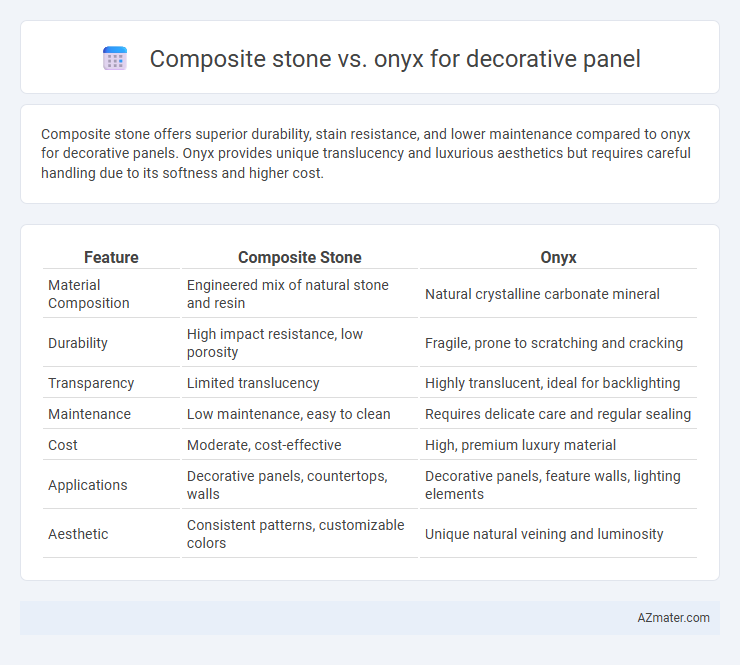Composite stone offers superior durability, stain resistance, and lower maintenance compared to onyx for decorative panels. Onyx provides unique translucency and luxurious aesthetics but requires careful handling due to its softness and higher cost.
Table of Comparison
| Feature | Composite Stone | Onyx |
|---|---|---|
| Material Composition | Engineered mix of natural stone and resin | Natural crystalline carbonate mineral |
| Durability | High impact resistance, low porosity | Fragile, prone to scratching and cracking |
| Transparency | Limited translucency | Highly translucent, ideal for backlighting |
| Maintenance | Low maintenance, easy to clean | Requires delicate care and regular sealing |
| Cost | Moderate, cost-effective | High, premium luxury material |
| Applications | Decorative panels, countertops, walls | Decorative panels, feature walls, lighting elements |
| Aesthetic | Consistent patterns, customizable colors | Unique natural veining and luminosity |
Introduction to Decorative Panels: Composite Stone vs Onyx
Composite stone offers high durability, stain resistance, and cost-effectiveness, making it a popular choice for decorative panels in both residential and commercial spaces. Onyx provides a unique translucency and luxurious aesthetic, often used in feature walls and backlit installations to create striking visual effects. Comparing composite stone and onyx highlights the balance between practicality and elegance in decorative panel selections.
Material Composition: What Are Composite Stone and Onyx?
Composite stone is an engineered material made from crushed natural stone, such as quartz or marble, mixed with resin and pigments to enhance durability and color consistency. Onyx, by contrast, is a naturally occurring carbonate mineral known for its translucent properties and distinctive layered patterns, often used in high-end decorative panels. The synthetic nature of composite stone allows for greater strength and customization, while onyx offers a unique, organic aesthetic prized for its light-transmitting qualities.
Aesthetic Appeal: Visual Differences and Design Flexibility
Composite stone offers a uniform, consistent appearance with customizable color and texture options, making it ideal for sleek, modern decorative panels. Onyx presents a unique, translucent quality with natural veining and vibrant patterns, adding depth and luxury to interior design. The design flexibility of composite stone caters to various contemporary styles, while onyx excels in creating focal points and dramatic visual impact through backlighting and natural variations.
Durability and Longevity Comparison
Composite stone offers superior durability compared to onyx, as it resists scratches, stains, and impact damage more effectively due to its engineered composition. Onyx, while prized for its translucent beauty and unique veining, is softer and more prone to chipping, cracking, and etching, especially in high-traffic or exposed environments. For long-term use in decorative panels, composite stone provides greater longevity with minimal maintenance, making it a more practical choice for durability-focused applications.
Maintenance and Care Requirements
Composite stone offers low maintenance with high resistance to stains, scratches, and moisture, requiring only regular cleaning with mild soap and water for long-lasting durability. Onyx, a softer natural stone, demands more careful upkeep, including sealing to prevent etching and staining, and gentle cleaning with pH-neutral products to preserve its translucent beauty. Choosing composite stone reduces maintenance efforts and costs, while onyx provides unique aesthetic appeal at the expense of increased care and protection.
Cost Analysis: Composite Stone vs Onyx
Composite stone offers a cost-effective alternative to onyx for decorative panels, with prices typically 40-60% lower due to its engineered materials and simplified manufacturing processes. Onyx, being a natural stone with unique veining and translucency, commands a premium price reflecting its rarity and the extensive labor required for extraction and finishing. When balancing budget constraints and design aesthetics, composite stone provides durable, visually appealing panels at a fraction of onyx's cost, making it a preferred choice for large-scale or cost-sensitive projects.
Installation Process and Complexity
Composite stone panels offer straightforward installation with lightweight properties and uniform thickness, allowing for easier cutting, drilling, and fixing using standard tools and adhesives. Onyx decorative panels require more skilled handling due to their fragile nature and translucency, often needing specialized substrates, careful sealing, and professional installation to prevent cracking or damage. The complexity of onyx installation increases costs and time, while composite stone provides a more user-friendly and durable solution for decorative wall applications.
Environmental Impact and Sustainability
Composite stone panels offer superior environmental benefits due to their use of recycled materials and lower energy consumption during manufacturing compared to onyx, which is a natural stone requiring intensive quarrying and transportation processes. The sustainability of composite stone is enhanced by its durability and recyclability, reducing waste and resource depletion, whereas onyx extraction causes significant habitat disruption and generates more carbon emissions. Choosing composite stone for decorative panels supports eco-friendly building practices by minimizing environmental footprint while maintaining aesthetic appeal.
Best Applications for Each Material
Composite stone offers superior durability and resistance to scratches and stains, making it ideal for high-traffic decorative panels in commercial spaces and kitchens. Onyx features unique translucency and vibrant veining, perfect for backlit walls, luxury interiors, and accent pieces where aesthetic appeal is paramount. Choosing between composite stone and onyx depends on balancing the need for robustness versus visual impact in decorative panel applications.
Conclusion: Choosing the Right Decorative Panel Material
Composite stone offers superior durability, cost-effectiveness, and ease of maintenance compared to onyx, making it ideal for high-traffic areas and long-term use. Onyx provides unmatched translucency and natural beauty, creating a luxurious and unique aesthetic that enhances upscale interiors. Selecting between composite stone and onyx hinges on balancing budget constraints with design goals, prioritizing durability for practical applications or striking visual impact for premium decorative panels.

Infographic: Composite stone vs Onyx for Decorative Panel
 azmater.com
azmater.com